ROADMAPS
Is there a clean coal roadmap for the U.S.?
In 2010 the U.S. Department of Energy and the National Energy Technology Laboratory (NETL) released a Clean Coal Technology Roadmap. It served as a unified roadmap, incorporating roadmaps from the Department of Energy, the Electric Power Research Institute (EPRI), and the Coal Utilization Research Council (CURC).[1]
This roadmap set clean coal performance targets through 2020, in support of the following initiatives:
- Clear Skies - Meets existing & emerging SO2, NOx, Hg regulations
- Clean Coal Power - Provides emerging near-zero emission technologies for demonstration
- Climate Change - Supports research to reduce CO2 emissions at acceptable costs
- Homeland Security - Keeps low-cost, abundant domestic coal competitive energy resource for the future [2]
In November 2021, the Biden Whitehouse released an updated net-zero plan, The Long-Term Strategy of the United States: Pathways to Net-Zero Greenhouse Gas Emissions by 2050.
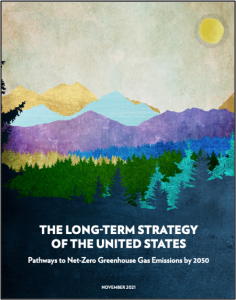
In this roadmap, solar and wind generation continues to increase substantially through 2050 and nuclear generation could see growth in the 2030s and 2040s. Unabated fossil generation (coal or gas generation without CCS technology) declines, and existing fossil fueled plants start to be fitted with carbon capture.
By 2050, clean generation provides zero emission electricity to the rest of the economy, with all electricity providing 15-42% of primary energy [3], as seen in this graph from the U.S. 2021 net-zero roadmap:
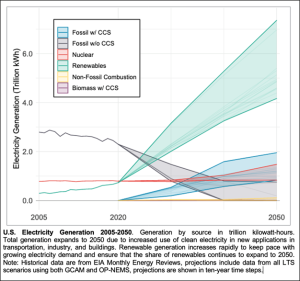
Source: U.S. Executive Office of the President [4]
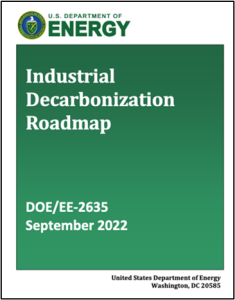
In September 2022, the Biden Administration’s Department of Energy released its Industrial Decarbonization Roadmap. This roadmap presents approaches to achieving net-zero greenhouse gas (GHG) emissions in the industrial sectors, based on four “pillars” of decarbonization: increasing energy efficiency; industrial electrification; adopting low-carbon fuels, feedstocks, and energy sources (LCFFES); and increasing carbon capture, utilization, and storage (CCUS).
While this roadmap document does not specifically use the phrase “clean coal,” the roadmap clarifies that the term “low-carbon” (as in low-carbon fuels, feedstocks, and energy sources, or LCFFES) refers to a technology, fuel, or process, with low net GHG emissions to the atmosphere, as opposed to the carbon content of the fuel or energy source being utilized. For example, by capturing CO2 and by storing it underground, or utilizing it in a way that prevents its release to the atmosphere - this can enable the use of high carbon content fuels like coal to generate low-carbon electricity, or low-carbon heat [7], as illustrated in the figure below:
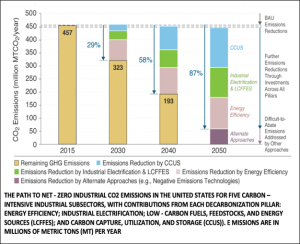
Source: U.S. Department of Energy [8]
This table from the industrial decarbonization roadmap illustrates the sector transformations needed to achieve decarbonization:
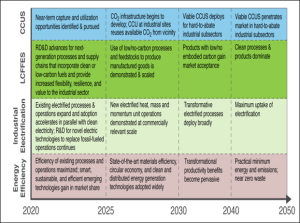
Source: U.S. Department of Energy [9]
This figure from the roadmap provides a composite view of RD&D needs across all subsectors to meet our 2050 decarbonization goal:

Source: U.S. Department of Energy [10]
Is There a Global Clean Coal Roadmap?
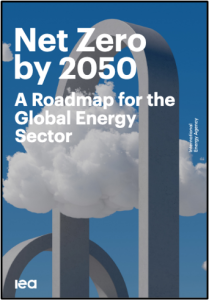
In October 2021, the International Energy Agency (IEA) published its 4th revision of Net Zero by 2050, A Roadmap for the Global Energy Sector. In this roadmap, the use of fossil fuels drops from almost four‐fifths of total energy supply in 2021 to slightly over one‐fifth by 2050. Unabated coal demand declines by 98% to just less than 1% of total energy use in 2050. Unabated coal power plants and the least efficient coal plants are phased out by 2030, and the remaining coal plants still in use by 2040 are retrofitted with CCUS. By 2050, almost 90% of electricity generation comes from renewable sources, with wind and solar PV together accounting for nearly 70% and most of the remainder coming from nuclear. [11]
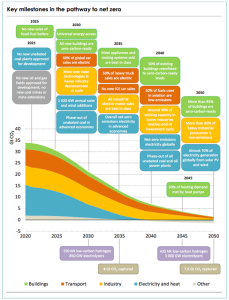
Source: International Energy Agency [12]
Mining of coal is expected to drop dramatically from 2019 to 2050, and mining companies are expected to turn to mining other raw materials vital to clean energy technologies. Revenues from critical minerals like copper, cobalt, manganese and various rare earth metals are expected to be larger than revenues from coal well before 2030, creating substantial new opportunities for mining companies, as presented in this IEA roadmap graph:
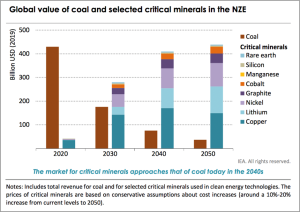
Source: International Energy Agency [13]
Updated November 2022, Tina Allen

Comments are closed.